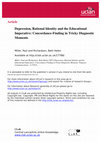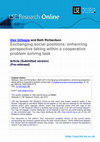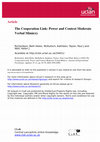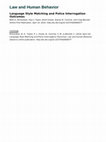Papers by Beth Richardson

Legal and Criminological Psychology, 2021
Purpose. Rapport-building has beneficial effects in investigative and security contexts. However,... more Purpose. Rapport-building has beneficial effects in investigative and security contexts. However, there remains limited understanding of the extent of agreement between different parties in their judgments of rapport. Methods. We observed 133 mock suspect interviews, and subsequently surveyed the lead interviewer and secondary interviewer (trainees undertaking an undergraduate Policing programme), the 'suspect' (an actor), and an expert observer (a retired, highly experienced police detective). Each of these parties provided subjective judgments of the degree of rapport that had been formed between suspect and lead interviewer. Furthermore, we assessed whether these subjective judgments were associated with the degree of 'Language Style Matching' (LSM) between lead interviewer and suspect: a key linguistic measure of interpersonal synchrony. Results. The suspect, secondary interviewer, and expert observer had generally good agreement about the degree of rapport achieved, as evidenced through significant, moderate to strong correlations between their rapport ratings. However, these parties' rapport ratings were weakly associated with those of the lead interviewer. Our linguistic analysis provided similar results: the extent of LSM was significantly associated with suspects' and the expert's subjective ratings of rapport, but not with the interviewers' ratings. Conclusions. The findings suggest that the demands of interviewing might impede interviewers' insight into the success of their rapport-building efforts, leading them to overlook cues that other parties rely upon. We discuss the need for future experimental manipulations to directly test this suggestion, and we consider the value of interpersonal synchrony in defining and measuring rapport. Rapport-building has been shown to foster cooperation with both cooperative and uncooperative interviewees in investigative contexts. As such, rapport is a fundamental part of well-established models of investigative interviewing (Powell, Fisher, & Wright, 2005; Walsh & Bull, 2012). Nevertheless, little remains known about how reliably interviewers judge the effectiveness of their efforts to build rapport with interviewees. In this exploratory study, we examine whether mock interviewers' judgments of rapport This is an open access article under the terms of the Creative Commons Attribution License, which permits use, distribution and reproduction in any medium, provided the original work is properly cited.
Interview tactics: Using mimicry to encourage cooperation

Palgrave Communications, 2017
It is well-documented, within most medical and much health psychology, that many individuals find... more It is well-documented, within most medical and much health psychology, that many individuals find diagnoses of depression confusing or even objectionable. Within a corpus of research and practical clinical guidance dominated by the social-cognitive paradigm, the explanation for resistance to a depression diagnosis (or advice pertaining to it) within specific interactions is bordering on the canonical; patients misunderstand depression itself, often as an output of an associated social stigma that distorts public knowledge. The best way to overcome corollary resistance in situ is, logically thus, taken to be a clarification of the true (clinical) nature of depression. In this paper, exploring the diagnosis of depression in UK primary care contexts, the social-cognitive position embedded in contemporary medical reasoning around this matter is critically addressed. It is firstly highlighted how, even in a great deal of extant public health research, the link between an individual holding "correct" medical knowledge and being actively compliant with it is far from inevitable. Secondly, and with respect to concerns around direct communication in clinical contexts, a body of research emergent of Discursive Psychology and Conversation Analysis is explored so as to shed light on how non-cognitive concerns (not least those around the local interactional management of a patient's social identity) that can inform the manner in which ostensibly "tricky" medical talk plays-out in practice, especially in cases where a mental illness is at stake. Finally, observations are drawn together in a formal Discursive Psychological analysis of a small but highly illustrative sample of three cases where a depression diagnosis is initially questioned or disputed by a patient in primary care but, following further in-consultation activity, concordance with the diagnosis is ultimately reached-a specific issue hitherto unaddressed in either DP or CA fields. These cases specifically reveal the coordinative attention of interlocutors to immediate concerns regarding how the patient might maintain a sense of being an everyday and rational witness to their own lives; indeed, the very act of challenging the diagnosis emerges as a means by which a patient can open up conversational space within the consultation to address such issues. While the veracity of the social-cognitive model is not deemed to be without foundation herein, it is concluded that attention to local interactional concerns might firstly be accorded, such that the practical social concerns and skills of practitioners and patients alike might not be overlooked in the endeavour to produce generally applicable theories.

Evidence for hand-size constancy: the dominant hand as a natural perceptual metric
Psychological science, 2014
The hand is a reliable and ecologically useful perceptual ruler that can be used to scale the siz... more The hand is a reliable and ecologically useful perceptual ruler that can be used to scale the sizes of close, manipulatable objects in the world in a manner similar to the way in which eye height is used to scale the heights of objects on the ground plane. Certain objects are perceived proportionally to the size of the hand, and as a result, changes in the relationship between the sizes of objects in the world and the size of the hand are attributed to changes in object size rather than hand size. To illustrate this notion, we provide evidence from several experiments showing that people perceive their dominant hand as less magnified than other body parts or objects when these items are subjected to the same degree of magnification. These findings suggest that the hand is perceived as having a more constant size and, consequently, can serve as a reliable metric with which to measure objects of commensurate size.

European Journal of Social Psychology, 2011
When people occupy different social positions within a cooperative task they experience discrepan... more When people occupy different social positions within a cooperative task they experience discrepant role and situation demands and thus have divergent perspectives. The reported research predicts that exchanging social positions within a cooperative task can overcome divergences of perspective. This prediction was tested in two experiments using the Communication Conflict Situation. The first experiment (n = 88) found that position exchange increased the ability of dyads to solve a communication conflict arising through discrepant perspectives. The second experiment (n = 120) found that the effect of position exchange exceeds that of purely cognitive perspective taking, thus suggesting that it cannot be reduced to a purely cognitive process. Exchanging social positions is a newly identified and powerful social mechanism through which perspective taking, within a cooperative task, can be enhanced.
Journal of Business and Leadership, 2007

Journal of Experimental Psychology: Applied, 2019
Drawing on theories of mimicry as a schema-driven process, we tested whether the degree of verbal... more Drawing on theories of mimicry as a schema-driven process, we tested whether the degree of verbal mimicry is dependent on the congruence between interactants' power dynamic (symmetric vs. asymmetric), task type (cooperative vs. competitive) and interaction context (negotiation vs. social). Experiment 1 found higher verbal mimicry amongst dyads who successfully completed a cooperative problem-solving task compared to those who did not, but only under conditions of symmetric, not asymmetric, power. Experiment 2 had dyads complete either a cooperative or a competitive negotiation task, under conditions of symmetric vs. asymmetric power. Verbal mimicry was associated with improved negotiation outcomes under conditions of cooperation and symmetry, and competition and asymmetry. Experiment 3 completes this picture by separating cooperativecompetitive orientation from the interaction context. Consistent with Experiment 2, verbal mimicry was associated with task success during a negotiation context with asymmetric power, and during a social interaction context with symmetric power. Our results point to the contextual link between verbal mimicry and task outcome.
Journal of Individual Differences

Law and Human Behavior, 2014
This research examined the coordination of interrogator and suspects' verbal behavior in interrog... more This research examined the coordination of interrogator and suspects' verbal behavior in interrogations. Sixty-four police interrogations were examined at the aggregate and utterance level using a measure of verbal mimicry known as Language Style Matching. Analyses revealed an interaction between confession and the direction of language matching. Interrogations containing a confession were characterized by higher rates of the suspect matching the interrogators' language style than interrogations without a confession. A sequence analysis of utterance-level Language Style Matching revealed a divergence in the type of matching that occurred across outcome. There was a linear increase in interrogator-led matching for interrogations containing a confession and an increase in suspect-led matching for nonconfession interrogations. These findings suggest that police interrogations play out, in part, at the basic level of language coordination.





Uploads
Papers by Beth Richardson